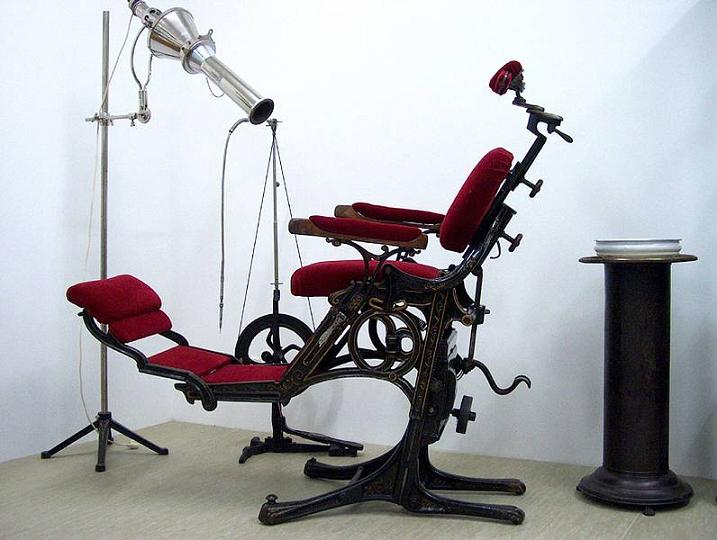Call for the rescue of the largest dental museum
31/12/2018
Ignored to death: Germany's only Dental History Museum. Lack of motivation of a professional group.
Published by courtesy of the Dental History Museum Zschadraß.
When McSwacz opened the Leipziger Volkszeitung on October 17, 2018, the agenda of the day was immediately fixed: visit the Dental History Museum in Zschadraß near Colditz, before it closes at the end of the year. Located in a magnificent Diakonie park, halfway between Leipzig and Dresden, the museum is housed in the former "Clubhouse", one of the magnificent, but in need of renovation, redbrick buildings there.
Master dental technician Andreas Haesler and his equally committed wife have spent many years investing money, time and commitment in a project that threatens to fail due to adverse circumstances. Roof renewal etc. and staff are no longer to finance. Every year, the association has to shell out 8,000 euros in running costs only for the lower floor of the museum. With 2000 visitors and 2850 euros over contributions of the supporting members per year an unequal relationship, finds the museum initiator, on whose 1420 begging letters for the provisional roof repair not even the postage came in.
Even though the museum presents a very impressive exhibition on the history of dentists, dental technicians, dental hygiene, art and cultural history in this field. The Quadriga Dentaria archive houses the world's most extensive collection, preserving this heritage for scientific work and public use. The DZW had reported in detail (https://www.dzw.de/dentalmuseum-skurrile-schaetze-der-zahnmedizin). Collected by the master dental technician Andreas Haesler, works from 170 libraries from Germany and abroad are also included, as are the holdings of the Dental History Institute in Vienna. Although there are smaller collections at some universities, none of the eight purely dental collections has more than 250 m². In Colditz, Haesler presents exhibits on 300 square meters, which is only a fraction of the more than half a million exhibits, six times more than in Utrecht. While elsewhere on average about five percent of the knowledge around the tooth are stored, it is 80 percent in Zschadraß alone.
Even the National Museum of Dentistry in Baltimore and the British Dental Museum and others can not match the size of the Saxon collection.
A polemic: identity without historical derivation
I have always been proud to practice dentistry and, in view of the rapid technological developments of recent decades, always with respect and humility for the services of our often miserably pecuniary and socially rewarded predecessors. This respect makes it necessary to get upset about how irresponsibly the committed (residual) legacy of a whole profession is handled. Starting with us dentists, our associations, the dental industry to the universities, with a few exceptions.
Because: Cultural heritage helps to learn. It conveys knowledge from the past, be it technology, materials, design, crafts, economics or social relations. It teaches us appreciation of our predecessors as well as the former living and working conditions. Frivolity in dealing with it leads to oblivion or the arrogant misjudgment of one's own skills. Dental instruments, units, objects, etc. not only document the practice of dentistry in a kind of dusty horror cabinet, they also stand for craft skills in the social context of medical and cultural history. This is all the more remarkable as the profession has only recently gained academic recognition, which is why the achievements of that time can not be appreciated enough retrospectly. The museum is a valuable treasure for us and our next generations. Commitment to the preservation and sharing of knowledge such as from Andreas Haesler and his assistants in this "Louvre" of dentistry - also on the part of the public hands - to punish with ingratitude and disrespect, is nothing less than irresponsible.
Rescue for the museum?
Shifting responsibility only to the city of Colditz and the Free State of Saxony is not effective, even if their willingness to act tolerates an impetus.
After all, there are about 71,000 working dentists, 200 dental companies, 9,828 dental laboratories in Germany, many of which also promote social and other projects, the Free Association and other associations and organizations. Also 17 dental associations, the federal dental association and the Federal Chamber of Dentists.
But: Only the Dentists Association Saxony-Anhalt and the Dentists Association of Bavaria have drawn a supporting membership in addition to the Dr. Walser Dental GmbH, the Bimler Labor KG Wiesbaden and a private person. After an excursion to the museum of the Federal Chamber of Dentists, meeting in Leipzig, except a thank you letter - Nothing! This is a shameful confession of ones own history.
If only a part of the dentists donate a small amount, all dental associations become sponsoring members, dental companies and laboratories are involved as sponsors, training and publications refer to the museum and its problems, then not only this jewel of dentistry will be saved. One also contributes to the preservation or creation of jobs in a structurally weak but scenic area. That people and museums not only have a perspective in a big city, but that they can be proud of being involved in a great cause in rural Germany that is not found anywhere else in the world.
Photo and text: Dental History Museum Zschadraß
Heading: Dr. Walser Dental
See also: Donation of Dr. Walser Dental for worldwide unique dental museum
And: Further support of the worldwide greatest dental museum through Dr. Walser Dental




